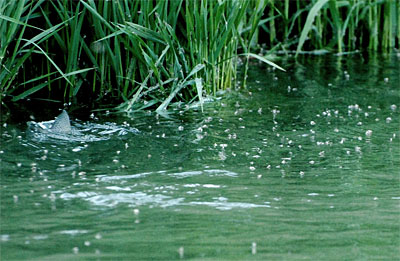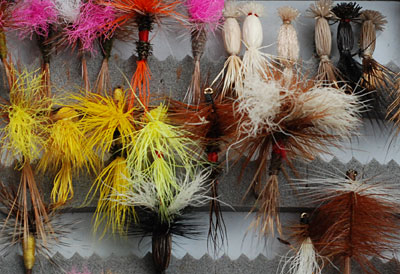Using Indicator Flies
Have a question you want answered? Email it to us at [email protected].
Question: What is the best thing to do when a caddis hatch is coming off and a feeding frenzy is on, but the river is full of bubbles and the caddis are a size 18’s or 20’s and you can’t see your fly very well, although you dry up about every fourth cast?
The Birddog, via email

“Blizzard hatches” can produce so many insects that it’s difficult to see your fly among all the naturals. Scott Butner photo
Answer: This rather breathless question—made more so by the author’s use of polysyndeton, a favorite device of the late Bill Tapply—suggests a certain frustration on the part of Mr. Dog (Mr. Birddog? One wonders how the Times would handle this). This is understandable, for there are few more maddening situations in fly fishing than watching fish gorge themselves right in front you but being unable to catch them because you can’t see your fly.
The easiest solution is to use an indicator fly, one that contrasts with the water you’re fishing. If there are a lot of white bubbles and glare, perhaps something with a black wing will stand out. I also tie indicator patterns parachute-style or Comparadun-style—with wings of fluorescent orange, pink, and chartreuse—and a body of peacock herl and thread (à la Royal Wulff). Not only do these flies stand out against the water or any bubbles and debris, but they also attract and occasional fish looking for a change of pace from the naturals floating by.

Virtually any hi-viz pattern — from a hopper to a Royal Wulff — can be used as an “indicator fly.” Phil Monahan photo.
Tie your indicator pattern at the end of the tippet, and fish the more imitative fly on a 24- to 30-inch dropper. (You can learn all about tying dropper rigs here.) Once your cast has landed, you can use the indicator fly to locate the approximate position of your smaller imitation. When you see a rise near your indicator fly, set the hook. Sometimes, you’ll some up with nothing, but you’ll be quick on the draw if a fish eats your dropper fly. If the fish are striking hard, your indicator fly will probably go under, making it even easier to detect a strike.











